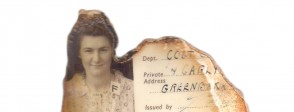Show students a picture of Thelma Barlow’s works pass. What can they tell from it? Gather all the information and ask for informed guesses, for example, about the title of the department. How important do they think it was? Are there any clues about the period the pass belongs to? What condition is it in and what do they think has happened to it? Compare the complete pass belonging to Nellie Nicholls in For the classroom. Probe further into why a worker might need a pass like this, guiding them towards issues of security and sabotage. Ask them what they think may have happened to Thelma’s pass.
The next two ideas are for exploring the raid itself. The first is a structured activity; the second is a more open-ended source analysis.
Explain that the pass was retrieved from a factory that was bombed by the Germans in the World War II. Show students the images of the Parnall Aircraft factory before the raid in A bigger picture and For the classroom. Identify what was being made there. Why would the factory be a target for air raids? Show students the images of the Luftwaffe crew and aerial reconnaissance photograph. How did they know the factory was there? How did they find it? Then use sources A and B in the pdf in A bigger picture to fill out what happened.
Make up resource packs from the materials in A bigger picture. Distribute to groups of students and ask them to prepare a script for a TV documentary about the raid. They need to include factual information and also discuss the reasons for the raid and give a sense of the participants’ experiences. An alternative would be to divide your class and ask some students to write a report about the air raid for the local newspaper and the others to write a report for a national newspaper. What image would they use to illustrate their article? How does the local audience make a difference to how they report the incident?
The next three teaching ideas use the complete works pass, the photos and the PDF of written sources on women at Parnall’s in For the classroom.
Make source packs and hand them out to groups of students. Get them to work out from the images and the written sources how many different jobs women did at Parnall’s and what kinds of jobs they were. Why do students think these jobs were thought to be suitable for women? Look at source B in the PDF: why were there no women designers or draughtsmen?
From what students already know about what happened in the air raid and the roles of women in Parnall’s, look again at the memorial to those who died in A bigger picture. How many women died, compared with men? What could be the reasons for the higher death toll among male employees?
Play an audio clip of an air raid siren from For the classroom. Ask students to choose a woman from one of the sources and write a diary entry about the day of the air raid. What did they think and do on hearing the siren? What happened to them? How did they get out? What did they do then? How did they feel when they had to go back to work?
Here are two broader enquiries that could follow on from some of the initial activities above.
Why did people keep going to work during World War II?
Use About the object and the photos and pdf in A bigger picture to pull out as much as possible about people’s experience of the raid. Do some initial exploration by asking the students to imagine being on the train home after the bombing of their work place. What are they going to tell their family? How are they going to describe the scene? Then ask them to consider a dilemma: there is a war on, they work in an essential place, it is the best work opportunity they have ever had and the pay is good, but it is also dangerous; do they want to go back and is there a workplace to go back to? Develop the enquiry further by gathering the reasons why people may have been able to overcome their fears and follow these up with research. Consider how the government could persuade people to overcome their fears – look at ways this was done in World War II. Consider the differences for men and women and how each was represented and appealed to by official publications and propaganda.
What difference did World War II make to women’s lives?
Use the example of Parnall’s as a starting point, then extend the enquiry by looking more broadly at the work women did during World War II and how that was different from the situation before the war. Trace the changes in women’s employment over the post-war years up to the present day using themes such as education and training, changes in family relations, women and trade unions, types of job, equality of pay, government policies. It would be informative to compare the different situations after the two world wars. Students could create a sequence of women or series of generations born at intervals during the twentieth century and create profiles for each of them demonstrating what aspects of their working lives have changed and what has remained the same or similar.


